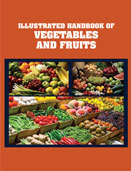Handbooks

This illustrative handbook details all the aspects of fruits and vegetables such as preservation and processing techniques as well as nutritional impacts. The book is designed to be a valuable source and for product developers, students and all professionals with an interest in this field. Fruits and vegetables are universally promoted as healthy. They are important part of healthy eating and provide a source of many nutrients, including potassium, fiber, folate (folic acid) and vitamins A, E and C. A diet rich in vegetables and fruits can lower blood pressure, reduce risk of heart disease and stroke, prevent some types of cancer, lower risk of eye and digestive problems, and have a positive effect upon blood sugar which can help keep appetite in check.
Fruit and vegetables should be an important part of your daily diet. They are naturally good and contain vitamins and minerals that can help to keep you healthy. They can also help protect against some diseases. Fruits and vegetables contain many vitamins and minerals that are good for your health. These include vitamins A (beta-carotene), C and E, magnesium, zinc, phosphorous and folic acid. Folic acid may reduce blood levels of homocysteine, a substance that may be a risk factor for coronary heart disease. Vegetables and fruit contain phytochemicals, or plant chemicals. These biologically active substances can help to protect you from some diseases. Fruit is the sweet, fleshy, edible part of a plant. It generally contains seeds. Fruits are usually eaten raw, although some varieties can be cooked. They come in a wide variety of colors, shapes and flavors. Different fruits grow in different countries. The nutrition value of fruits places them on the crest of our edibles. Fruits contain vitamins and minerals in large quantities. Fruits are the oldest food of mankind. Taking fruits everyday strengthens our vitality. Nutrition scientists advise us to take at least 115 grams of fruit every day for balanced diet. But at present our country has the capacity to provide each of us with only 38 grams of fruits every day. We need fruits for economic reasons too. Most fruit trees live for years. Fruit farming is quite profitable although it may be a little expensive at the beginning. Fruits can be processed for preservation in many ways. For example, different kinds of healthy foods like jam, jelly, candy, etc. and drinks can be made from fruits. Some fruits can be dehydrated for marketing. In Illustrated Handbook of Vegetables and Fruits, we?ll explore a number of vegetables and fruits, for each vegetable and fruit, we?ve included information on the necessary garden, as well as planting information and special considerations that will be valuable to reap the benefits of vegetables and fruits. Vegetables are rich and comparatively cheaper source of vitamins. Consumption of these items provides taste, palatability, increases appetite and provides fiber for digestion and to prevent constipation. Their consumption in plenty fair amount of protein. They also play key role in neutralizing the acids produced during digestion of pretentious and fatty foods and also provide valuable roughages which help in movement of food in intestine. Some of the vegetables are good sources of carbohydrates (leguminous vegetables, sweet potato, potato, onion, garlic and methi) proteins (peas, beams, leafy vegetables and garlic) vitamin A (carrot, tomato, drumstick, leafy vegetables), Vitamin B (peas, garlic and tomato), Vitamin C (green chillies, drumstick leaves, Cole crops, leafy vegetables and leaves of radish) minerals (leafy vegetables, drumstick pods). As per diPREFACE etician, daily requirement of vegetables is 75 - 125 g of green leafy vegetables, 85 g of other vegetables and 85 g of roots and tubers with other food. The Illustrated Handbook of Vegetables and Fruits covers the propagation, planting, harvesting, and storage of fruits and vegetables and culinary aspects as well.